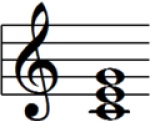
Music Theory 101
When I start teaching a new banjo, guitar or mandolin class, I first ask my students whether or not they know their alphabet. These students, many whom are adults, look at me with a bit of disdain, as though I just asked a question that is far beneath their level of intelligence. After all, we all learned our alphabet in kindergarten, didn’t we?. So they answer, “Yes .. we know our alphabet”. Be careful, I say. This is a trick question.
A to G
Say your alphabet real fast from “A” to “G”. Now say it backwards real fast from “G” to “A”. Going forwards was easy wasn’t it? Did you hesitate on the way backwards though? If you’re honest, you will say that you hesitated if not simply stopped between letters. You see, the majority of us never learned our alphabet going backwards.
Sharps (#) and Flats (b)
Now the good news. In music you only need to know the alphabet from “A” through “G”. There is no “H” note or beyond in music. Seems rather easy. The “not so good” news is that we throw in these notes called sharps and flats between most of the musical alphabet but not between every note. Why make it easy on you right? For the beginning music student, the musical alphabet just got a little complicated. The sharps and flats are known as enharmonics because they provide two letter names for one single note. The notes A through G are called natural notes and can best be remembered as all the white keys on the piano.
We don’t have an equal number of sharps (#) and flats (b) as we do natural notes (A through G). Think of your fretted instrument as though you were playing a piano. It is important that you remember which notes do not have sharps or flats between them. The answer is that “B” to “C’ and “E” to “F” do not have sharps and flats between them. Those are the same two sets of white keys that are next to one another on the piano. Let’s not forget though, that a fretted instrument doesn’t have keys but uses fret.
So there is your musical alphabet from A to G. Throw in the sharp and flats and you have twelve notes in all.

But my question is…..why have we changed this in America….??? everywhere else it’s Do Re Mi Fa Sol La Ti (Si in Spanish) Do….yet here we’ve gone to the alphabet! Does anyone know why???? And by the way, the musical alphabet IS a foreign language to those that try it for the first time!
It is amazing how otherwise intelligent people (at least in my estimation) are challenged by saying the alphabet backwards from G. I always seem to visualize a piano keyboard (took lots of piano lessons) which slows me down when I have to go to the fretboard. I guess this takes practice like everything else. G – F – E- D – C – B – A.
that wasn’t so hard.
Simple enough when you’re playing say in open G on the banjo. Easy to memorize and quickly find those I, IV and V chords (G, C, D respectively in key of G). Now add the capo, say at the third fret (open A# or Bb) and the pattern starts changing)………the I, IV and V chord relationships remain the same, regarding fret spacing, but the looks of the fretboard with those “here’s where you are fret markes” is different………..now the instructor throws in a flatted-seventh or a relative minor chord and I’m done. I hope I get to meet the grascal who invented all this stuff and purposefully put in those gotchas…..reminds me of spelling classes some 55-60 years ago……..”I before E, except after C, or “…….hated it then too! So are there any short cuts to this rote memory technique? (I actually designed a sliding fret marker system once….)
I find the musical alphabet fascinating. And the more I study guitar, the more elegant the system appears. I am now learning more about playing chords beyond the basic one and playing “up the neck” of the guitar. I have to build more hand strength to play bar chords well, but I like the flexibility of having many versions of each chord, each of them with a slightly different sound.